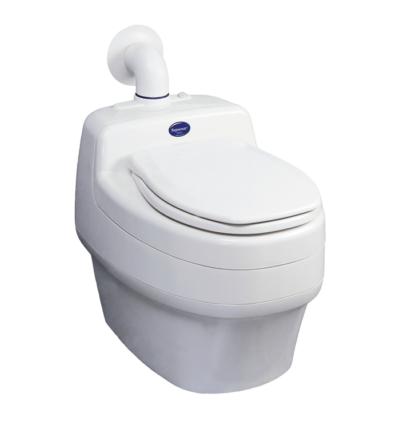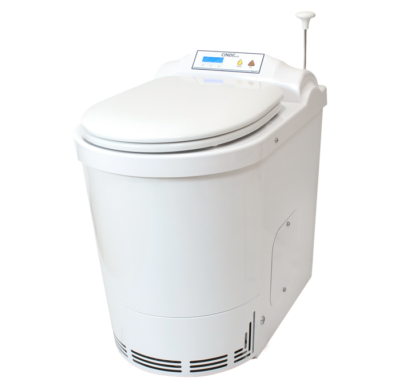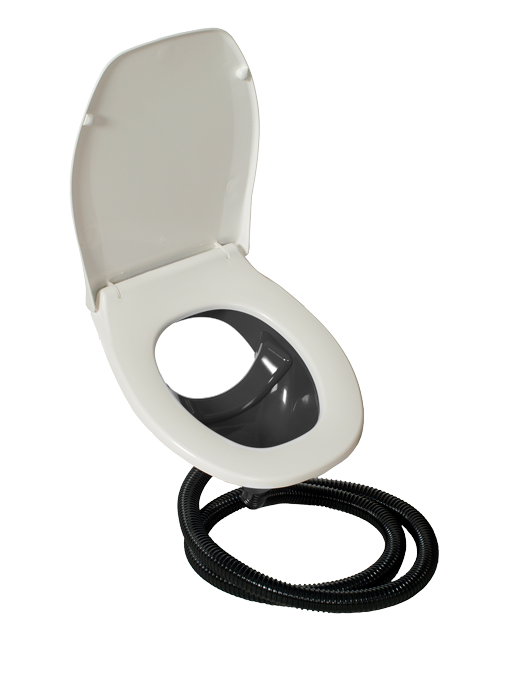
Separett has been pioneering the design and manufacture of waterless toilets in Sweden since the 1990’s. Today, as a global business, Separett’s knowledge and experience have influenced and informed the design, functionality and ongoing development and refinement of their products.
With the backup and support of our approachable and friendly experts here at WooWoo, together with Separett’s class-leading warranties and a wide range of UK-stocked spares, you’re making the right choice by buying your Separett waterless toilet from WooWoo.


A well-designed waterless toilet should be attractive, simple to use, odour-free and hygienic – all qualities you experience with Separett. They consider the whole system and that approach can be seen in the detail of products such as the Separett Villa and the all-new Separett Tiny – features like an automatic cover screen, the efficient odour removal fan (no sawdust required), the female-friendly design and the easy-to-clean materials used throughout.
These tried and tested features make for the best user experience and a better overall investment.
That’s why the Separett Villa has become the world’s best-selling compost toilet with sales of over 120,000 units. And now with the new Separett Tiny, you have the possibility of having a Separett waterless toilet in camper vans, boats and other mobile dwellings.
Separett designs, develops and manufactures a comprehensive range of waterless toilets to suit a range of budgets and requirements. The friendly team here at WooWoo are happy to have a chat or email discussion about your requirements and will advise you on the most appropriate solution for your needs.
Launched in 2021, the all-new, award-winning Separett Tiny comes in two models, one that has a removable urine container and one that diverts the urine to the outside. You can now enjoy the freedom of a waterless compost toilet in your boat, camper van or mobile home.
The Tiny uses the tried and tested Separett urine-separator design, an automatic concealing flap over the solids container and efficient ventilation system that requires no sawdust. All packed in a modern, elegant and compact design!


Separett Villa and Villa Extend are domestic-style urine-diverting compost toilets, proven for year-round use in houses, sheds, garden offices, shepherds huts, glamping pods and the like.
With a range of user-friendly features such as automatic concealing cover (obscures the view into the solids area until the user sits down), quiet fan for continuous ventilation and odour-free operation, the Villa looks great and performs exceptionally.
The Villa has a large (23l) automatically rotating solids container but if you need more capacity, the Villa Extend has a 50-litre, external (underfloor) solids collection capability.
Separett Family II is an all-electric incinerating toilet that safely and hygienically evaporates liquids and turns everything else into a small amount of ash.
Ideal for use by a typical family (2 adults and 2 children), it plugs directly into a 13amp socket.


The Separett Privy 500 and Privy 501 are the original urine diverter! Hugely popular all over the world, it’s the ideal starting point if you want to build your own ‘rustic’ compost toilet or to upgrade your existing outhouse to a urine-diverting design.
Available with a warm cellular foam seat (Privy 500) or a traditional white seat and lid (Privy 501). There’s even a wooden seat optional extra for those that want a more traditional style.
To enhance and improve the usefulness and simplicity of owning a waterless toilet, Separett has designed a range of high-quality accessories and consumables. From a child-friendly separating adaptor seat, compostable and biodegradable bags, a range of ventilation parts, and more.

You can find all the popular products from the Separett catalogue in our online shop, including the Villa and the all-new Tiny. We also stock a wide variety of spare parts, accessories and consumables, like compostable bags and urinal blocks. If you need something you can’t find in the shop, let us know and we’ll do our very best to get it to you as soon as possible.
Don’t forget to have a look around the ‘More Info’ section of our website, where you’ll find details on how they work, how to deal with urine, how to compost and much more!
If you have any questions, call one of our friendly experts now on 020 3051 0738!
By default, the semi-flexible urine hose that comes with the Separett Villa, Tiny and Pee is two metres long. We sell them as spares, but we’d not recommend using them in excess of 2 metres as there is a risk of the pipe sagging over time (and allowing urine to collect and possibly calcify). You can buy an adaptor (from plumbing merchants) that will enable you to connect rigid 32mm push-fit or solvent weld pipe which you can then run over a longer distance. Always ensure you have a fall of 1cm per metre to ensure adequate and speedy flow.
Yes. We keep a wide range of the most common spares in our UK warehouse for the Villa and Tiny. Many are listed on our website, but if you have any trouble finding what you are looking for, please get in contact.
Spares for older models are also available – just let us know what you’re after and we’ll be able to help.
It’s always best to use the official Separett pipework where possible because you are assured of a perfect fit and long-term performance. However, there may be situations where this isn’t possible, such as getting the vent pipe around awkward objects or reducing the number of ninety-degree bends.
Flexible pipe (commonly sold as dust extraction pipework) is available in 50mm (for the Tiny) and 75mm (for the Villa) diameters. Try to keep the overall length as short as possible as the flexible pipes often has reinforcing rings which may cause some turbulence and lower the air flow efficiency.
Ideally no. The reason is that bathroom extractor fans remove a large volume of air and could, in some circumstances, overpower the fan in the toilet, drawing odours out. If the toilet is in a fairly large room, this might not be a problem.
If building regulations are applicable, and you must have an extractor van, keep the ‘on’ time for the extractor to a minimum.
Not directly. The internal ventilation fans on the Villa and Tiny both run on 12V DC (the Villa draws around 2 watts and the Tiny is around 1.5 watts). The supplied mains adaptor reduces the 230V AC mains supply to 12V DC.
If you want to run the fan from a 24V supply, we would recommend fitting a voltage regulator to reduce the 24V DC supply to 12V.
Not necessarily! However, the branded compostable bags, bio-drain tablets and absorb mats are guaranteed to fit and perform as you’d expect. Third-party consumables may be slightly compromised in terms of fit and function, but the choice is yours.
No. A correctly constructed soak-away pit doesn’t smell because the urine is discharged under the ground. Naturally occurring soil bacteria will start to feed off the nutrients in the urine.
There will be some odour detectable at the point the vent pipe terminates outside. However, this will disperse very quickly and is not apparent within a metre or so. Longer vent pipes are available for the Villa and Tiny should you wish to run the vent pipe higher or to a different place.
Yes. The Separett Tiny and Villa urine-diverting toilets have been developed to have the fan running all the time. This not only keeps all odours out but also ensures that flies are not attracted to the toilet.
Having said that, we do have customers who turn the fan off overnight (using a timer switch) with generally no ill effects, although it must be stated that the manufacturer does not recommend this.
Turning the fan on and off can also shorten the service life of the fan.
It depends on which model you have and your preferences in terms of composting or disposing of the contents.
The Separett Tiny has the smallest solids container and will need emptying after 7-10 days of full-time use by one person. The Separett Villa will last between 6-8 weeks with the same usage and the Separett Villa Extend, with associated 50-litre solids container will be around twice that.
The amount of toilet paper being used will also affect the overall capacity, more so with the Tiny. You can, of course, empty the solids container at any time you choose – there’s no need to wait until it’s full. In a glamping installation, the site operator is likely to want to empty the toilet on guest changeover day.
The urine container in the Separett Tiny should be emptied every 1 – 2 days even if it’s not full. Urine will tend to deposit a ‘scale’ inside the container if left.
When they are new, it’s not uncommon for the Separett Tiny to make a noise as you open the top part and/or when you open the concealing screen to access the solids container. These noises will lessen over time, although some lubrication may help – check out our video for more details..
Probably not – the most likely reason is that the urine container has not been placed correctly. We’ve made a short video which shows how you can check and correct this. If the urine container is not fully seated, the alert light will stay on to warn you.
We’ve produced a short video which shows you what to do: click here.
Our preferred method of dealing with the solids (faeces) from a urine-diverting compost toilet is always to compost them in a compost bin (see our page on composting) as they ‘close the loop’ and return valuable nutrients safely to the earth. However, there may be situations, such as in motor homes or boats, where it’s impossible to compost on the go or store anything for later composting at home or on land.
In these situations, you may be able to dispose of small amounts (under 7kg) in municipal waste bins or official council waste disposal sites (the waste will be classed as non-recyclable and is typically used in an energy recovery process) provided the contents are double-bagged and clearly labelled (you can buy ‘tiger bags’ for such a purpose). The contents are referred to as ‘offensive waste’ and come under the same waste classification as used nappies and adult incontinence pads.
If you have permission from a land-owner, you could also bury the contents in the earth. Make sure you are away from a water course, and ensure wildlife and other people can’t easily come into contact with your ‘gift’.
If you’re on a canal or river, never discharge urine or faeces into the water (we hope that’s obvious!), and don’t use the bins provided by the CRT (Canals and River Trust) as they prohibit compost toilet disposal in their bins (it’s a long story…).
Whatever method you choose, always dispose of solid waste safely and responsibly.
Beyond regular cleaning (as you would do with any toilet), a yearly or half-yearly inspection is advisable. Turn the power off (to stop the fan, if fitted), open the toilet and look at the mesh cover over the fan (on the Villa, this is at the back of the toilet, on the Tiny, the mesh is on the left of the concealer screen).
The cover is removable on the Villa, so take it off and brush off any debris as required. With the cover off, look inside and visually inspect the fan blades and if needed, gently brush off any debris with a soft brush. On the Tiny, the mesh filter can be detached from its position to the side of the concealing flaps. Replacement mesh screens are available if needed.
If you have a Villa, check the condition of the cables that operate the concealer screen and bucket rotation. Use an appropriate lubricating product (such as a silicone lubricating spray, suitable for metals and plastics) if needed to ensure the cables run smoothly and are protected from corrosion.
Thoroughly clean any debris from within the body of the toilet. If you need any advice or parts, please contact us.
Keeping the urine container as clean as possible is key to ensuring the long life of the internal level sensor and reducing odours. Regular (ideally daily) emptying and rinsing will help. Occasionally we suggest a stronger cleaner, such as Ecover Toilet Cleaner, is used to remove any urine that has crystallised inside.
For the Separett Tiny, we recommend a maximum length of 4 metres with a couple of ninety-degree bends. It is possible to fit a second fan to the Tiny if you need a longer vent pipe run or more bends, but this will increase the noise levels.
For the Villa (models made after 2020), you can have up to six metres of vent pipe. For more information on possible Villa vent pipe configuration and the range of parts, see this page.
Urine separation works best when the user is fully seated. This way, urine will go to the front of the separator and solids will drop down through and into the rear section.
If someone hovers or stands, there’s a chance for things to miss. However, if you’re that one-in-a-million man who has a ‘perfect’ aim, then you can of course stand!
With the Separett Tiny and Villa, odour control takes two forms. Initially, the separation of urine and faeces means there is not the classic ‘latrine’ type odour. Secondly, the ‘always-on’ fan draws air over the solids container and pushes out the foul air through the expertly designed fan and vent pipe, ensuring an odour-free user experience.
No. The toilet (both the BASIC and FAMILY) will need to be pulled forward off the ventilation pipe for regular maintenance (cleaning the vent pipe outlet on the rear of the toilet). In addition, if the toilet is not going to be used for a period of time, it should only be switched off (ie the fan stops) if it’s pulled forward from the vent pipe. Otherwise, condensation can settle inside the toilet.
Probably not. There are two main things to consider, the available space and the available power.
Space – the ventilation pipe is 110mm in diameter and the initial slow 90º bend is installed behind the toilet, which will take up considerable room.
Power – the Separett BASIC and FAMILY are designed for 100% mains electric use. During the initial phase (about 40 mins), the temperature of the incineration chamber is raised to 550ºC, during which time, the current draw is approximately 10 Amps (1.8Kw) continuously. Once at this temperature, the incineration phase commences, which maintains the temperature for the duration of the cycle (20-40 minutes depending on the model and the program chosen).
Yes, it’s REALLY important that after each use, you ‘flush’ (press the flush plunger to enable the bag and contents to drop into the incineration chamber) and then press the appropriate button (the incinerate button on the BASIC and either ‘small/urine’ or ‘large/faeces’ on the FAMILY).
If you don’t press the incineration program, there is a good chance that the contents will not be fully incinerated.
Yes! It’s important not only for the overall cleanliness and appearance of the toilet bowl, but the bags also ensure that the contents fall evenly and completely into the incineration area.
As of June 2023, the latest software/firmware version of the Separett Family (aka CINDI Family) is 2.03. All models of the FAMILY should be running the latest version. For details of how to update, please download this PDF: https://separett.com/files/documents/Update%20Software%20Cindi%20Family_version_2.03.pdf
In simple terms, it uses an electric heating element to evaporate urine and incinerate solids to a small amount of hygienic ash.
When you use the toilet and press the button to start the incineration program, the heating element is turned on to raise the temperature within the incineration chamber to 550ºC (this cycle takes 35-40 mins depending on the ambient air temperature). At this point, the incineration cycle starts – on the BASIC, this runs for about 40 minutes, and on the FAMILY it’s 20 minutes for the ‘small’ program and 40 minutes for the ‘big’ program. Once complete, the fan will continue to run at full power for 20 minutes or so until the temperature inside has dropped to under 90ºC.
Other people can use the toilet whilst it’s on an incineration cycle – it’s important that they still press the appropriate incinerate button when they’re done so that the toilet can add an additional incineration time to the program to ensure the contents are fully incinerated.
For long and trouble-free service, please observe the following installation and use guidelines:
After 50 uses the ash pan will need to be emptied
After 100 uses the toilet will need an ashpan clean (placing water in the ashpan and choosing an incineration program – the steam will clear urine salt deposits)
After 100 uses the toilet should be pulled forward from the vent pipe and the pipe cleaned with the supplied cleaning brush to remove any soot deposits
After approx. one year of full-time use or two years of part-time use, the toilet will need a service which includes internal cleaning, checking of key components and replacement of the heating element.
Not sure which toilet is right for you, need a quote or want to know a little more information?
Help us advise you by telling us a little about your situation - or even better, give us a call to discuss options!
Alternatively, you can write us an email at:
or give us a call on:
Sign up to our newsletter to receive WooWoo news and offers
Like us on Facebook
Suppliers














